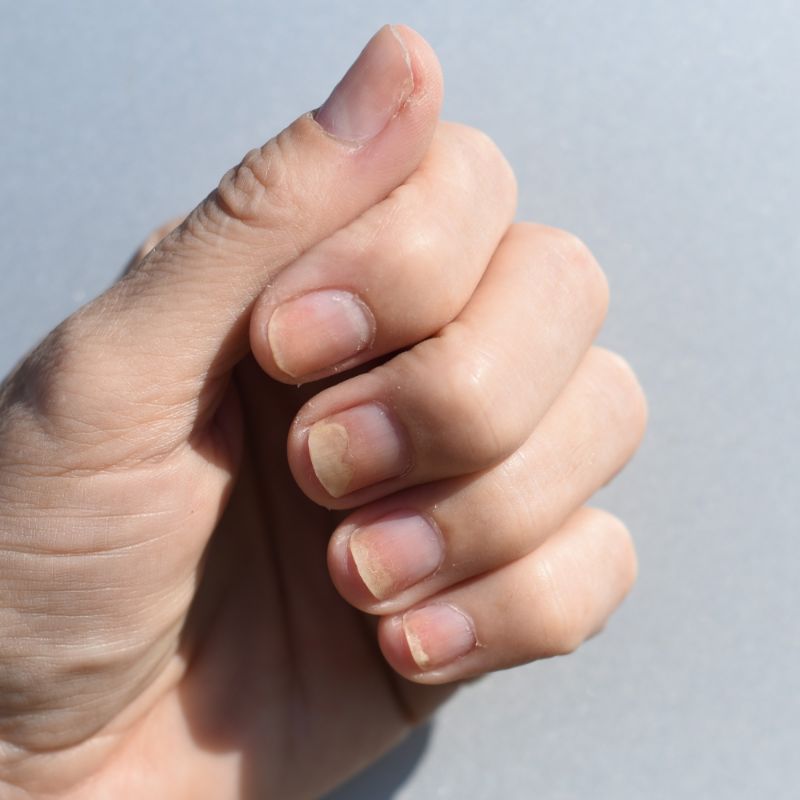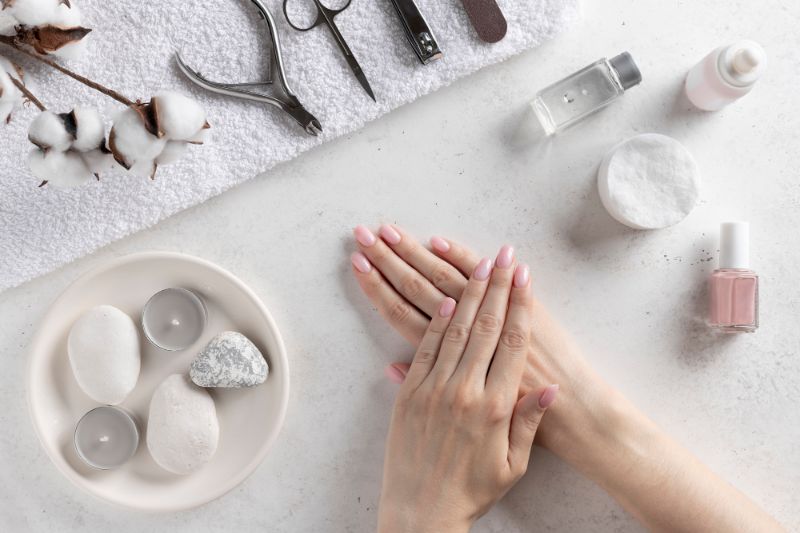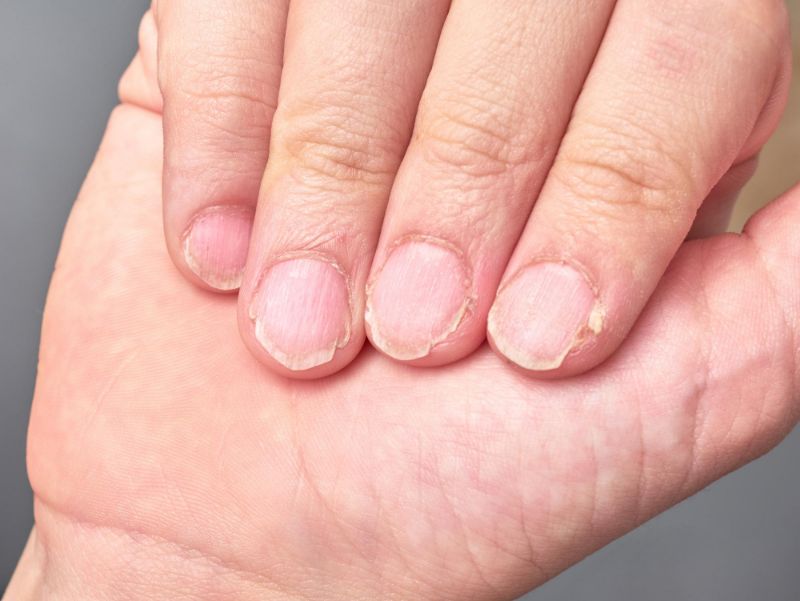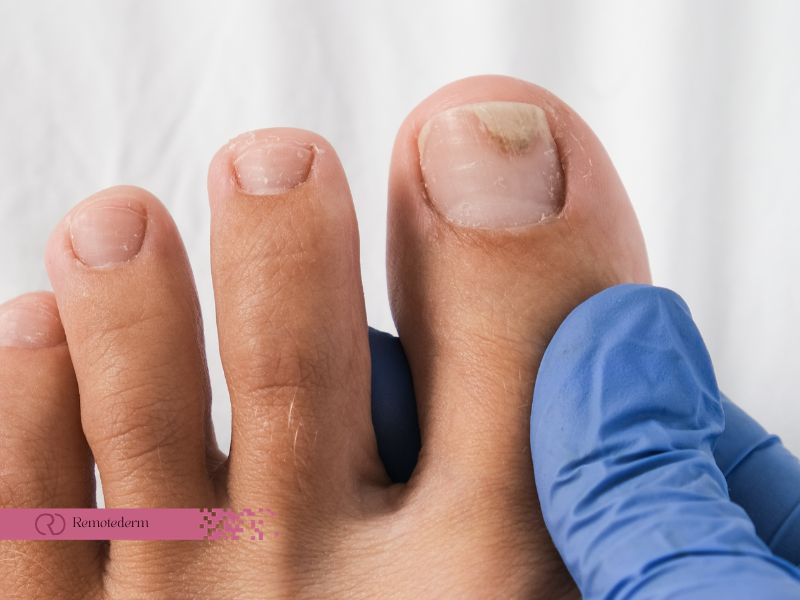Nail problems are a common concern, and one that often goes unnoticed is onycholysis. In this comprehensive guide, we will explore onycholysis, its causes, and how to address it effectively. If you’ve been troubled by nails that seem to detach from the nail bed, you’ve come to the right place. Let’s delve into the world of onycholysis and understand how to get rid of it.
What is Onycholysis?
Onycholysis, also known as nail separation, is a condition where the nail plate separates from the underlying nail bed. This separation often starts at the tip of the nail and progresses towards the base. It can affect one or more nails and is usually a painless condition. However, it can be a cause of concern for anyone experiencing it.
Onycholysis Causes
Onycholysis, or nail separation, can be triggered by a variety of factors. Let’s take a detailed look at the different causes that can lead to this condition:
- Trauma to the Nails: Physical injury or repeated trauma to the nails, such as excessive tapping or pounding, can result in onycholysis. This can weaken the connection between the nail plate and the underlying nail bed.
- Infection: Fungal or bacterial infections can infect the area around the nail, leading to onycholysis. These infections weaken the nail bed and cause the nail to detach.
- Allergies: Some individuals may develop allergic reactions to nail products, such as nail polish, acrylics, or adhesives. These allergies can cause inflammation and damage to the nail bed, resulting in onycholysis.
- Psoriasis: Nail psoriasis is a condition in which the nails are affected by psoriasis, a chronic autoimmune skin disease. Psoriasis can lead to changes in the nails, including onycholysis. The exact cause of onycholysis in psoriasis is not fully understood but is thought to be related to inflammation and immune system dysfunction.

It’s important to note that onycholysis can also be caused by other factors, including certain medications, thyroid disorders, and systemic illnesses.
Can Gel Nails Cause Onycholysis?
Gel nails, although popular for their durability and shine, can sometimes contribute to onycholysis. The prolonged use of gel nails or improper removal can damage the natural nails, leading to separation.
How to Get Rid of Onycholysis?
Addressing onycholysis nail, involves a combination of preventive measures and treatment options. Here are some strategies to help get rid of onycholysis and maintain healthy nails:
- Proper Nail Care: Maintaining good nail hygiene is crucial in preventing and managing onycholysis. To avoid its onset, make sure to keep your nails clean, dry, and well-trimmed. Trimming the nails straight across and not too short can help prevent nail trauma.
- Avoid Trauma: Physical trauma to the nails is a common cause of onycholysis. Be cautious and take measures to prevent injury. Use appropriate protection, such as gloves, when engaging in activities that may damage your nails, especially repetitive tasks that involve tapping or pounding.
- Manage Infections: If your onycholysis is caused by a fungal or bacterial infection, it’s essential to seek professional help. Consult a dermatologist for a proper diagnosis and treatment. They may prescribe antifungal medications or antibiotics to combat the infection, helping to restore the connection between the nail and the nail bed.
- Safe Nail Products: For those who are prone to allergic reactions, it’s wise to choose nail products that are gentle and hypoallergenic. Some individuals develop allergies to nail products like polish, acrylics, or adhesives, which can lead to onycholysis. Selecting products specifically designed for sensitive skin can minimize the risk of such reactions.
- Healthy Diet: Your overall health plays a significant role in the condition of your nails. Consuming a balanced diet that’s rich in essential vitamins and minerals can contribute to the overall health of your nails. Nutrients like biotin, zinc, and iron are particularly important for nail health. Including a variety of foods such as lean proteins, whole grains, fruits, and vegetables in your diet can help support healthy nails.
In addition to these measures, it’s crucial to consult a healthcare professional or dermatologist if you suspect you have onycholysis or are experiencing nail problems. They can provide you with a proper diagnosis and offer personalized guidance on the most effective treatments and preventive measures for your specific situation. Remember that the successful management of onycholysis often requires a combination of lifestyle changes and medical interventions tailored to your needs.
If you suspect that a fungal infection is causing your onycholysis, consult with an online nail fungus dermatology service. They can provide expert guidance and treatment options to address the issue effectively.
Onycholysis Prevention

The best approach to onycholysis is prevention. By taking proactive measures, you can reduce the risk of developing this nail condition. Here are some additional steps to keep your nails healthy and strong:
- Maintain Optimal Nail Hygiene
Keep your nails clean and dry. Trim them regularly, and avoid biting your nails. Use a gentle nail brush to clean underneath your nails and prevent the buildup of dirt and bacteria.
- Protect Your Nails
When engaging in activities that may expose your nails to trauma, such as gardening or housework, consider wearing protective gloves to safeguard your nails from potential damage.
- Avoid Harsh Chemicals
Opt for nail products that are free from harsh chemicals like formaldehyde, toluene, and acetone. These substances can weaken your nails and make them more susceptible to onycholysis.
- Avoid Excessive Moisture
Prolonged exposure to moisture, whether from frequent hand washing or wearing wet gloves, can soften the nails and make them more prone to separation. Ensure your nails are dried thoroughly after any contact with water.
Nail Conditions to Watch Out For

In this section, we will explore nail conditions that are important to be vigilant about when dealing with onycholysis. These conditions may include fungal or bacterial infections, nail psoriasis, and other potential complications that can impact the health and appearance of the nails:
Nail Psoriasis
Nail psoriasis is a condition that affects both the nails and skin. It can lead to onycholysis, pitting, and other nail abnormalities. If you suspect you have nail psoriasis, consult a dermatologist for diagnosis and management.
Nail Fungus
Nail fungus or fungal infections on or around nails can be a common culprit behind onycholysis. It’s important to recognize the signs of a fungal nail infection, such as discoloration and thickening, and seek prompt treatment.
Nail Diseases Chart
This nail diseases chart is a quick reference chart to help you understand various nail diseases and conditions:
| Condition | Symptoms | Treatment |
| Onycholysis | Nail separation, painless | Proper nail care, infection management |
| Nail Psoriasis | Pitting, discoloration, nail thickening | Dermatologist-prescribed treatments |
| Nail Fungus | Discoloration, thickening, brittle nails | Antifungal medications, topical treatments |
Final Thoughts
In summary, understanding and preventing onycholysis, or nail separation, is crucial for maintaining nail health. This guide has provided insights into its causes, prevention, and treatment. By practicing good nail hygiene, avoiding trauma, and making informed choices about nail products, you can reduce the risk of experiencing onycholysis and related complications.
It’s essential to be aware of potential nail conditions that may arise alongside onycholysis, such as nail psoriasis or fungal infections. Seeking professional guidance and prompt treatment when needed can help preserve the health and appearance of your nails. Ultimately, the key to managing onycholysis is proactive prevention, which empowers you to maintain strong and beautiful nails throughout your life.
FAQs
- Is onycholysis a painful condition?
Onycholysis is usually painless, but it can be a cause for concern due to its impact on nail appearance and health.
- Are there any medications to treat onycholysis?
If the cause is an infection, antifungal or antibiotic medications may be prescribed.
- How long does it take for onycholysis to improve with treatment?
The duration varies based on the underlying cause and treatment, but improvement can take several weeks to months.
- Can I continue using nail polish with onycholysis?
Using hypoallergenic nail products is advisable, but consult a dermatologist for personalized guidance.
